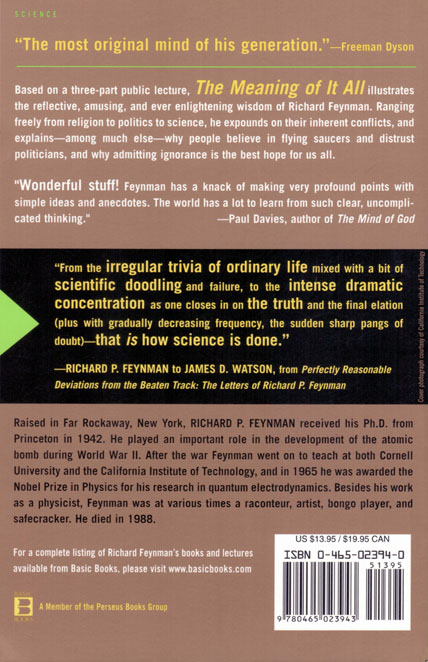The Meaning of It All (14 page)
Read The Meaning of It All Online
Authors: Richard P. Feynman

Problems
farm,
65â66
grappling with,
56â57
what is probable,
77
Products, health,
97
Programs
Point Four,
7â8
Ranger,
112â13
Promises, campaign,
66
Propaganda and going to moon,
113
Proportion, sense of,
105
Proteins
of bacteria,
11â12
of humans,
11â12
Protocol of the Elders of Zion,
106
Psychoplasmic
inheritance,
53
Questions, asking intelligent,
65
Radioactivity
danger from,
107
protection from effects of,
108â9
unsafe level of,
107â8
Radio religion people,
94â95
Ranger program,
112â13
Read, ability to,
116
Real estate in California,
96
Reasoning
and positive inventions,
18
scientific,
18
Relations among scientists,
21â22
Relationships, human,
22
Religion
as answering all kinds of questions,
41
ethical aspect of,
41
and inspiration,
47
inspirational aspects of,
41â42
metaphysical aspects of,
41â42
radio people,
94â95
Religious beliefs,
43
Religious experiences,
39â40
Reporters, newspaper,
88â89
Resurgence of
Germany, fear of,
52
Rules
to be checked,
23
and consistency of science,
23
exception tests,
15â16
powerfulness of,
20
specificity of,
19
testing of,
19
that describe nature,
24
Russia
backward country,
50
and biology,
53â54
development of ideas,
55
and modern art,
55
not free,
53
Sampling,
Science
Arabian scholars of,
115
contents of,
9
development speed of,
62
doubt as value in,
28
facts learned in,
38â39
imagination in,
22â23
key to gates of heaven,
6â7
limitation of,
63
meaning of,
4â5
as method,
15
as misunderstood,
36â37
objectivity of,
18â19
philosophy of,
18
practical aspects of,
9
and religion
conflict between,
35
relation of,
34â35
rules and consistency of,
23
and society relationships,
7
and technology,
50
three aspects of,
4â5
uncertainty of,
1â28
value of,
6
Scientific realm, moral values as outside,
43â45
Scientific reasoning,
18
Scientists
as atheists,
36
dealing with doubt and uncertainty,
26â27
relations among,
21â22
Seaton, Mother,
77â79
Society and science, relations between,
7
Speech, parts of,
115â16
Spinning of tops,
24â26
S.P.X. Research Associates,
102
,
105
Statistical sampling,
84
,
89â91
Stupidity, phenomena result of a general,
95
Systems, traffic,
118
Technology
applications of,
62
and science,
50
Telekinesis,
68
Telepathy, mental,
71â74
Television
advertising in,
85
looker, intelligence of average,
87â88
Testing, nuclear,
106â7
Theories, allowing for alternative,
69
Thoroughness, concept of,
17
Tops, spinning,
24â26
Traffic systems,
118
Troubles and lack of information,
91
Truth
of ideas,
21
writing,
56
Uncertainties
admission of,
34
relative certainties out of,
98
remaining,
70â71
of science,
1â28
scientists dealing with,
26â27
of values,
29â57
Uncertainty,
67â68
Universe
contemplation of,
39
origins of,
12
Unscientific age,
59â122
Values
ethical,
43
moral,
120â21
uncertainty of,
29â57
Venus
flying saucers from,
75
Mariner II voyage to,
109â12
Vocabulary,
116
War, dislike of,
32
Water, and deserts,
96
Weight, as not affected by motion,
24
Western civilization,
47
Witch doctors,
114
Words, as meaningless,
20
Writing truth,
56
Born in 1918 in Brooklyn, Richard P. Feynman received his Ph.D. from Princeton in 1942. Despite his youth, he played an important part in the Manhattan Project at Los Alamos during World War II. Subsequently, he taught at Cornell and at the California Institute of Technology. In 1965 he received the Nobel Prize in Physics, along with SinâItero Tomanaga and Julian Schwinger, for his work in quantum electrodynamics.
Dr. Feynman won his Nobel Prize for successfully resolving problems with the theory of quantum electrodynamics. He also created a mathematical theory that accounts for the phenomenon of superfluidity in liquid helium. Thereafter, with Murray GellâMann, he did fundamental work in the area of weak interactions such as beta decay. In later years Feynman played a key role in the development of quark theory by putting forward his parton model of high energy proton collision processes.
Beyond these achievements, Dr. Feynman introduced basic new computational techniques and notations
into physicsâabove all, the ubiquitous Feynman diagrams, which, perhaps more than any other formalism in recent scientific history, have changed the way in which basic physical processes are conceptualized and calculated.
Feynman was a remarkably effective educator. Of all his numerous awards, he was especially proud of the Oersted Medal for Teaching, which he won in 1972.
The Feynman Lectures on Physics
, originally published in 1963, were described by a reviewer in
Scientific American
as “tough, but nourishing and full of flavor. After 25 years it is
the
guide for teachers and for the best of beginning students.” In order to increase the understanding of physics among the lay public, Dr. Feynman wrote
The Character of Physical Law
and
Q.E.D.: The Strange Theory of Light and Matter
. He also authored a number of advanced publications that have become classic references and textbooks for researchers and students.
Richard Feynman was a constructive public man. His work on the Challenger commission is well known, especially his famous demonstration of the susceptibility of the O-rings to cold, an elegant experiment, which required nothing more than a glass of ice water. Less well known were Dr. Feynman's efforts on the California State Curriculum Committee in the 1960s where he protested the mediocrity of textbooks.
A recital of Richard Feynman's myriad scientific and educational accomplishments cannot adequately
capture the essence of the man. As any reader of even his most technical publications knows, Feynman's lively and multisided personality shines through all his work. Besides being a physicist, he was at various times a repairer of radios, a picker of locks, an artist, a dancer, a bongo player, and even a decipherer of Mayan hieroglyphics. Perpetually curious about his world, he was an exemplary empiricist.
Richard Feynman died on February 15, 1988, in Los Angeles.

